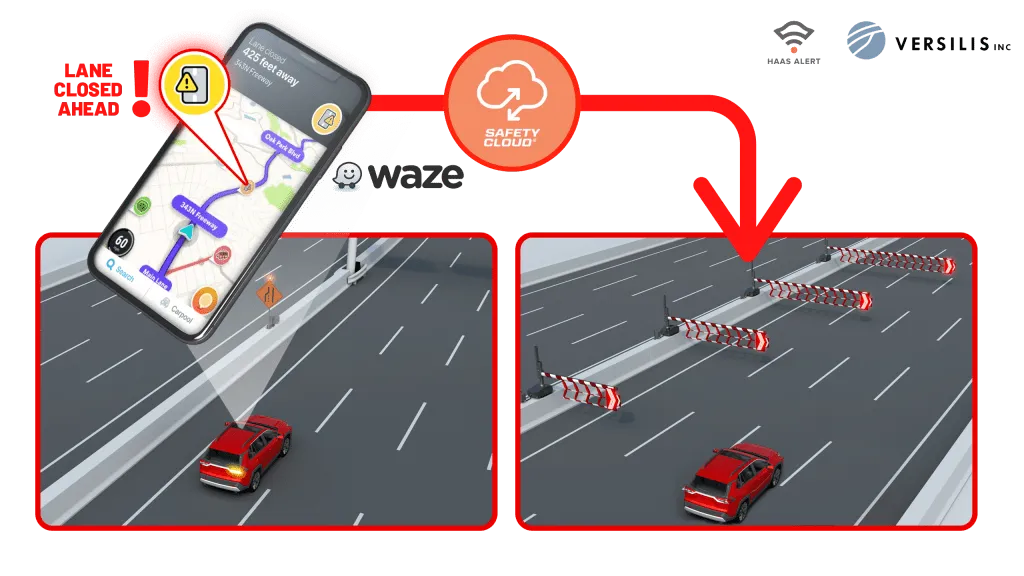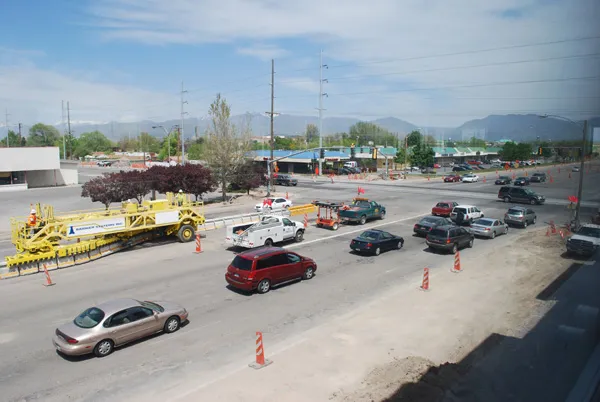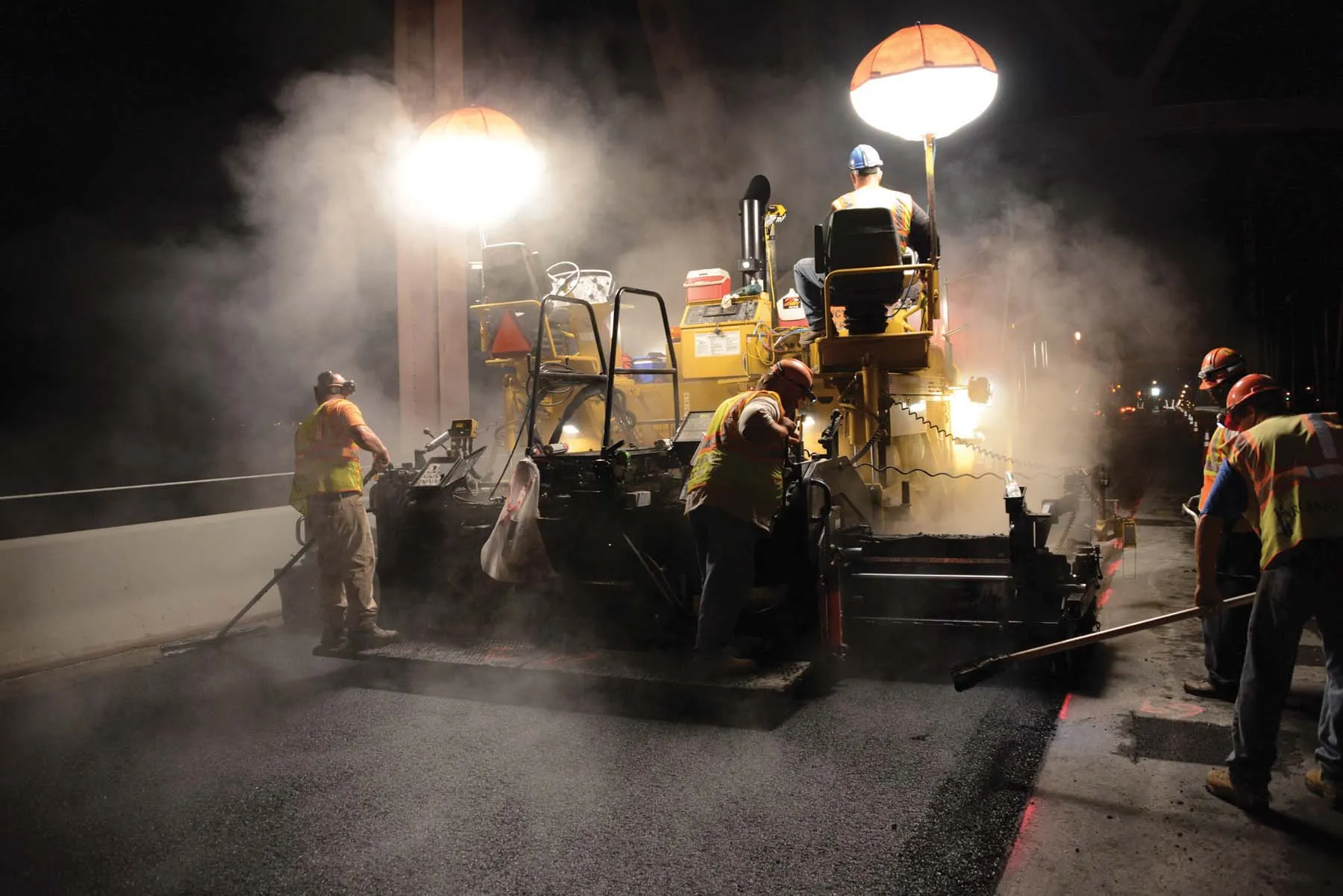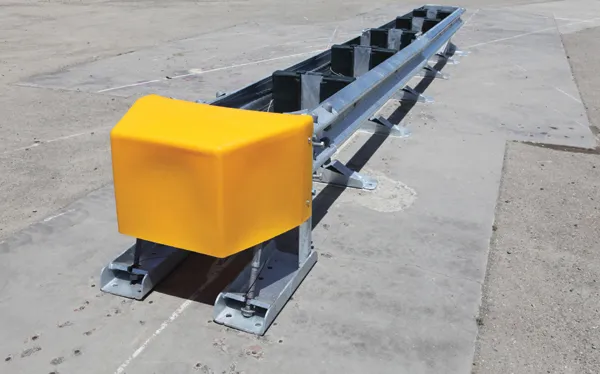Globally renowned highway work zone safety solution manufacturers have been providing some of their latest systems to protect roadworkers and motorists on high volume traffic highways. Guy Woodford reports
Versilis has provided one of its state-of-the-art work zone safety solutions during the rehabilitation of North America’s busiest highway.
The Canadian road safety product innovator and manufacturer was retained by the Ministry of Transportation of Ontario (MTO) to install automated traffic control
December 3, 2013
Read time: 6 mins
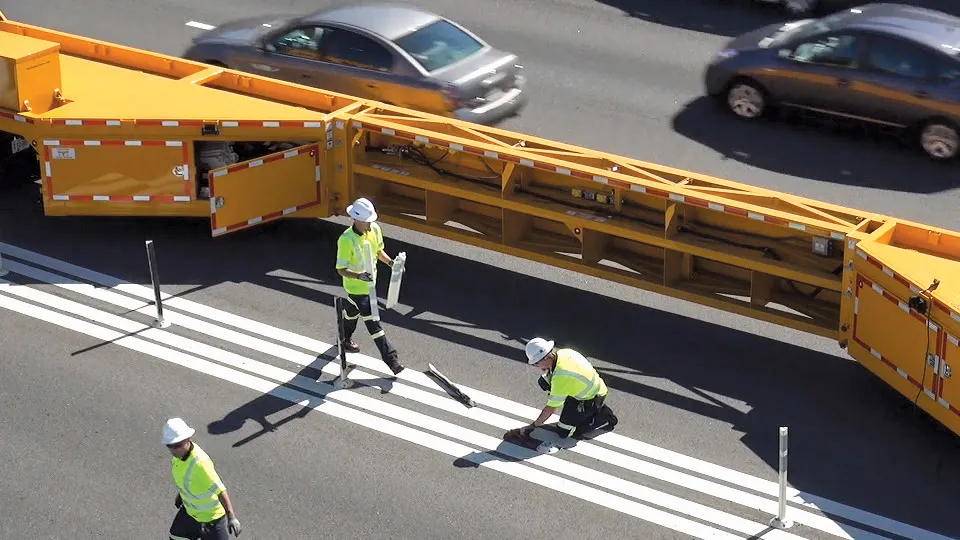
Globally renowned highway work zone safety solution manufacturers have been providing some of their latest systems to protect roadworkers and motorists on high volume traffic highways. Guy Woodford reports
2303 Versilis has provided one of its state-of-the-art work zone safety solutions during the rehabilitation of North America’s busiest highway.
The Canadian road safety product innovator and manufacturer was retained by the Ministry of Transportation of Ontario (MTO) to install automated traffic control gates (SwiftGate) to facilitate the complex traffic management operation required for their Highway 400 /401 interchange rehabilitation.
The segment of Highway 401 passing through Toronto has average annual daily traffic (AADT) of more than 400,000 vehicles. The Highway is divided into Express and Collector Lanes that keep traffic moving. As part of the 400 /401 interchange rehabilitation project, Versilis worked hand in hand with the MTO and the general contractor to increase safety and efficiency of the traffic operations involved.
Key benefits of deploying SwiftGate is its high visibility with flashing LEDs that send a clear message to motorists that the lane is closed. The automated gates enable quick off-ramp opening and closing, allowing fast automated traffic operations giving more time to do rehabilitation work. SwiftGate’s remote activation increases operation safety, while their crashworthy composition ensures minimum damage to an impacting vehicle in case of an accident. Requiring minimum maintenance, SwiftGate is crash tested to NCHRP 350 TL-3 and accepted by the2410 Federal Highway Administration (FHWA).
6724 Mobile Barriers (MB) MBT-1 mobile barrier is being used by Transurban & Roy Jorgensen Associates (RJA) on the I-495 Express Lanes outside of Washington DC in the United States. The I-495 Capital Beltway carries an average of around 250,000 vehicles per day. Certain work, including delineator repairs, that had taken three nights is now said by Bruce Bartoes, regional manager for RJA, to be being completed in one, with greater safety for the crews and less interruption to the public.
Bartoe said that MBT-1 had become an important and integral part of their work, emphasising that its use is “the only way we allow our crews to access the road” for periodic daytime quality assurance inspections of roadway assets maintained by the firm. Eliminating the need for multiple pieces of equipment, such as a separate protective barrier, generator carts, utility trucks and flatbeds for supplies, the MBT-1 is said by MB to provide effective protection while allowing crews to work efficiently down the road with minimal interruption to passing traffic.
Also protecting against debris entering the work zone area or the roadway while traffic is moving, the MBT-1 is said by MB to work equally well for lane closures and for shoulder closures. It is said to help reduce distraction and glare, keeps more lanes open, and allows more uniform speeds during work repair hours. The 1.52m height of the MBT-1 mobile barrier prevents drivers seeing inside a work zone, preventing work zone traffic incidents.
As Bartoe stresses, safety is a number one priority, “It’s a challenge day and night – 24x7. During the day, there is heavy traffic. At night, there are a disproportionate number of impaired drivers. Use of the barrier helps not only while the crews are out there, but to the extent they can quickly pull in and do what they need to in one night, they are less exposed and the public is less impacted. There’s no better way to reduce work zone incidents and congestion than to complete the work the first night and open the road the other 66% of the time.”
Bartoe said traffic on the I-495 Express Lanes increased 38% for the quarter ended in June [2013], and the speed limit was increased in July [2013] from 88—104kph. “While these gains may not be directly attributable to use of the barrier, we like to think MBT-1 is helping, while keeping workers safer with less impact on passing traffic,” he added.
A winner of innovation awards from the2462 IRF, ARTBA and ATSSA, the company's MBT-1 mobile barrier last month had the further honour of being one of four innovations featured during the opening plenary ‘Lions’ Den’ session of the Transportation Association of Canada’s Annual Transportation Conference (TAC-ATC).
Often, traffic control companies are faced with creating a simple, efficient traffic pattern in busy, cramped construction zones.
These zones can be difficult to maintain, and repairing crash cushions can become a potential hazard to workers. Similar challenges were faced by Superior Traffic Control-Memphis (STC) of Tennessee in the United States, during a widening project on the I-240.
STC was awarded a contract that required the installation of 19 portable attenuators in various locations to shield openings in the project’s barrier wall. Several were to be placed at potentially hazardous locations where frequent impacts had been reported. Entrance and exit ramps also posed concerns to STC due to limited sight and merging distances for traffic.
All of these situations created a heightened awareness for STC’s employees when maintaining and repairing the existing attenuators as they became damaged. The maintenance was continuous, as numerous attenuators were hit multiple times within the first six months of the project.
Damaged units, cost of repairs and, most importantly, the proximity of STC’s workers to traffic flow during maintenance became issues for the contractor, and they began to look for an alternative product to place in these locations. STC looked for an attenuator with a minimal footprint that had the potential to have high residual capacity when impacted under NCHRP 350 criteria. They chose7402 Trinity Highway Products (THP) React 350 II.
When impacted within the parameters established by NCHRP 350, the React 350 II is said by THP to have the potential to sustain multiple hits before requiring repair or service, and the recently introduced unit has a footprint 2.74m shorter than its predecessor, the React 350.
The React 350 II was installed by STC in a location that had sustained the most repetitive hits. This particular attenuator was impacted multiple times, and after close inspection after each impact, STC was said to be pleased to discover that no repairs or adjustments were necessary. Rebecca Wood, president of STC, said, “Not only did it maintain a safe work zone by absorbing minor hits without exposing the project to the downtime required in repairing traditional units, it saved us time, labour and exposure because we were not repairing the it over and over again, as we had with the traditional product.”
Throughout the duration of the project, STC said that the unit saved the company thousands of dollars in repair and labour costs in just half a year’s time. Because of the initial savings as well as the improved worker environment, they installed a second unit on the I-240 widening project.
Highway agencies and municipalities also face the challenge of repairing and maintaining permanent roadside devices installed in potentially high-impact locations. THP says that recognising the value of crash cushions that have the potential to sustain multiple impacts before requiring repair or service can be a helpful tool for managing limited budgets.
The Canadian road safety product innovator and manufacturer was retained by the Ministry of Transportation of Ontario (MTO) to install automated traffic control gates (SwiftGate) to facilitate the complex traffic management operation required for their Highway 400 /401 interchange rehabilitation.
The segment of Highway 401 passing through Toronto has average annual daily traffic (AADT) of more than 400,000 vehicles. The Highway is divided into Express and Collector Lanes that keep traffic moving. As part of the 400 /401 interchange rehabilitation project, Versilis worked hand in hand with the MTO and the general contractor to increase safety and efficiency of the traffic operations involved.
Key benefits of deploying SwiftGate is its high visibility with flashing LEDs that send a clear message to motorists that the lane is closed. The automated gates enable quick off-ramp opening and closing, allowing fast automated traffic operations giving more time to do rehabilitation work. SwiftGate’s remote activation increases operation safety, while their crashworthy composition ensures minimum damage to an impacting vehicle in case of an accident. Requiring minimum maintenance, SwiftGate is crash tested to NCHRP 350 TL-3 and accepted by the
Bartoe said that MBT-1 had become an important and integral part of their work, emphasising that its use is “the only way we allow our crews to access the road” for periodic daytime quality assurance inspections of roadway assets maintained by the firm. Eliminating the need for multiple pieces of equipment, such as a separate protective barrier, generator carts, utility trucks and flatbeds for supplies, the MBT-1 is said by MB to provide effective protection while allowing crews to work efficiently down the road with minimal interruption to passing traffic.
Also protecting against debris entering the work zone area or the roadway while traffic is moving, the MBT-1 is said by MB to work equally well for lane closures and for shoulder closures. It is said to help reduce distraction and glare, keeps more lanes open, and allows more uniform speeds during work repair hours. The 1.52m height of the MBT-1 mobile barrier prevents drivers seeing inside a work zone, preventing work zone traffic incidents.
As Bartoe stresses, safety is a number one priority, “It’s a challenge day and night – 24x7. During the day, there is heavy traffic. At night, there are a disproportionate number of impaired drivers. Use of the barrier helps not only while the crews are out there, but to the extent they can quickly pull in and do what they need to in one night, they are less exposed and the public is less impacted. There’s no better way to reduce work zone incidents and congestion than to complete the work the first night and open the road the other 66% of the time.”
Bartoe said traffic on the I-495 Express Lanes increased 38% for the quarter ended in June [2013], and the speed limit was increased in July [2013] from 88—104kph. “While these gains may not be directly attributable to use of the barrier, we like to think MBT-1 is helping, while keeping workers safer with less impact on passing traffic,” he added.
A winner of innovation awards from the
Often, traffic control companies are faced with creating a simple, efficient traffic pattern in busy, cramped construction zones.
These zones can be difficult to maintain, and repairing crash cushions can become a potential hazard to workers. Similar challenges were faced by Superior Traffic Control-Memphis (STC) of Tennessee in the United States, during a widening project on the I-240.
STC was awarded a contract that required the installation of 19 portable attenuators in various locations to shield openings in the project’s barrier wall. Several were to be placed at potentially hazardous locations where frequent impacts had been reported. Entrance and exit ramps also posed concerns to STC due to limited sight and merging distances for traffic.
All of these situations created a heightened awareness for STC’s employees when maintaining and repairing the existing attenuators as they became damaged. The maintenance was continuous, as numerous attenuators were hit multiple times within the first six months of the project.
Damaged units, cost of repairs and, most importantly, the proximity of STC’s workers to traffic flow during maintenance became issues for the contractor, and they began to look for an alternative product to place in these locations. STC looked for an attenuator with a minimal footprint that had the potential to have high residual capacity when impacted under NCHRP 350 criteria. They chose
When impacted within the parameters established by NCHRP 350, the React 350 II is said by THP to have the potential to sustain multiple hits before requiring repair or service, and the recently introduced unit has a footprint 2.74m shorter than its predecessor, the React 350.
The React 350 II was installed by STC in a location that had sustained the most repetitive hits. This particular attenuator was impacted multiple times, and after close inspection after each impact, STC was said to be pleased to discover that no repairs or adjustments were necessary. Rebecca Wood, president of STC, said, “Not only did it maintain a safe work zone by absorbing minor hits without exposing the project to the downtime required in repairing traditional units, it saved us time, labour and exposure because we were not repairing the it over and over again, as we had with the traditional product.”
Throughout the duration of the project, STC said that the unit saved the company thousands of dollars in repair and labour costs in just half a year’s time. Because of the initial savings as well as the improved worker environment, they installed a second unit on the I-240 widening project.
Highway agencies and municipalities also face the challenge of repairing and maintaining permanent roadside devices installed in potentially high-impact locations. THP says that recognising the value of crash cushions that have the potential to sustain multiple impacts before requiring repair or service can be a helpful tool for managing limited budgets.


